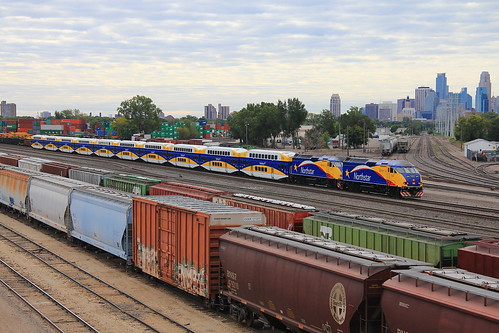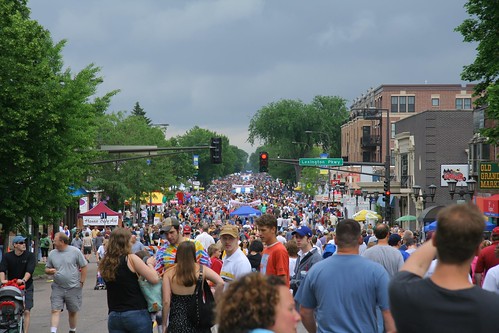 A super-sized weekend Northstar train from autumn 2010 which was set up for combined game-day loads of Vikings and Twins fans
A super-sized weekend Northstar train from autumn 2010 which was set up for combined game-day loads of Vikings and Twins fans
The Republican-held Minnesota legislature passed a funding cut for Metropolitan-area transit of $109 million for the 2012–2013 biennium, leaving only about $10 million in state-appropriated funding per year. Transit operators in the Twin Cities only pull in about $95 million per year in ticket revenue, so this is something akin to watching 55% of your riders suddenly disappear.
The legislation was overturned by a veto by Gov. Mark Dayton, but now that the Republicans have staked out such an egregious position, it's likely that Democratic politicians will cave to a cut much like the loopy
$69 million hack job proposed earlier in the House's session and a seemingly less-bad (at the time) $30 million-ish cut from the Senate instead. Metro Transit's rail operations are the meatiest targets for cuts, and I'm personally convinced that the earlier proposals (particularly the one from the Senate) were specifically intended to force the Northstar commuter and Hiawatha LRT services to be shut down—each of which require around $15 million in subsidy per year at the moment.
I personally could not justify cutting the Hiawatha Line, since it attracts so many riders to Metro Transit as a whole and carries them quickly for a relatively low cost per head (with
2008 data, it's about $1.44 subsidy/rider, with total cost of $2.32/rider). The Northstar is a different story. I hate to come to this conclusion, but the Northstar is currently an expendable service. The cost per rider is far too high, with subsidies in the vicinity of $20 per trip—That will likely go down over time, but looking at two-way trips for each day, that ends up being much more than the average cost to own a car. Considering that most Northstar riders will drive to the car-oriented stations in the first place, it's not an appropriate use of scarce resources.
I can justify subsidizing a trip at $20, $40, or even hundreds if it is only an occasional thing—a few times per week, month, or year—but not every day. This is why I think the Northstar should be converted into a regional rail service operating throughout the day rather than just during rush hours. I also still cling to the idea that it should be extended to St. Cloud, primarily because it has the potential to run a profit. Mn/DOT's
Minnesota State Rail Plan pegged the operating ratio at between 70% and 111%, and I feel those numbers could be very conservative—The same plan says that the farebox recovery for the Northern Lights Express to Duluth would be just 22% to 34%, even though corridor-specific studies have put it at more than 100% (and a positive operating ratio is a requirement for the Federal Railroad Administration funding source that they've been targeting).
Note that St. Cloud has a local airport, but it doesn't have any scheduled commercial service. Even if it did, it would probably be very overpriced. Using
other regional short-hop costs as a guide, a person could expect to pay $260 to $360 just to get from St. Cloud to the Twin Cities by air. Amtrak tickets on the frequently-delayed
Empire Builder are more like $20, but I figure there's plenty of headroom to increase prices for a reliable regional service.
Currently there are
14 12 individual trips per weekday (
6 5 inbound round-trips plus one reverse-commute round-trip) using
five four trainsets which park underneath Target Field in between the morning and afternoon rush periods. That's a waste of expensive equipment. (The three round-trips per weekend day just use one trainset.) Since each trip takes about 50 minutes, a single train could have been used to provide service every two hours on the route, or two trains could have been used to provide hourly service. Trips to St. Cloud would take about twice as long and would probably need twice as many trains to get the same service frequency.
$320 million has already been invested in the corridor for infrastructure and usage rights. Getting to the original vision for the service probably requires $100 to $250 million more, but a phased approach could make good improvements for much less. I think there's a strong possibility that a series of normal bank loans could be used to build the rest of the line at this point, either repaid through fare surpluses or by Mn/DOT in future years when our state legislators regain a sense of sanity.
The main choke point for service to St. Cloud is a segment of single-tracking that runs from the Northstar's Big Lake station to just beyond Becker, a distance of about 9 miles. Double-tracking had existed there in the past, and some grade crossings still have the extra set of tracks embedded in the asphalt. It should be easy to rebuild it for for $20 million or less. There might be some extra costs because Mn/DOT has claimed that the highway intersections along U.S. Highway 10 are too close to the tracks and would need to be reworked—Of course, that's Mn/DOT's fault for putting highway too close to the rails in the first place, but whatever.
Negotiating track usage rights for the extra distance to St. Cloud is a bigger question. If reductions in frequency could be tolerated, there might be room to reconfigure the service without requiring additional cost. The distance to St. Cloud is 66 miles vs. the 39 miles to Big Lake, so roughly
3.5 3 round-trips per day could be accomplished with the same allocation of train-miles per day. Those trips would be backed up to some extent by Amtrak's
Empire Builder from St. Cloud to Saint Paul (when it's not running 10 hours late or terminating due to flooding or other issues out west). Gaps in the low level of service would also be supported a bit by Jefferson Lines buses (operating essentially direct from Minneapolis to St. Cloud) and potentially the Northstar Link buses (the current method of getting from Big Lake to St. Cloud).
I'm sure that smallish $20 million or so loans could be repaid in just a few years if the Northstar became profitable. Even if such money couldn't be repaid through surpluses, the debt service plus operating subsidy would probably be less than today's ~$15 million yearly subsidy. With the current wave of fiscal insanity, we basically can't afford to subsidize Northstar at all, but this could be a way to keep it operating even through a period of through-the-bottom austerity.
I'll also just briefly mention the idea that BNSF could take over Northstar completely. Their crews already operate the trains and they wouldn't have to pay themselves for track usage rights, so it would be a pretty easy for them to do it (thought it would also be easy for them to cancel it).
[
Update 11/20/2011: I have often mis-read the Northstar schedule. There are only five inbound trips per peak period, not six like I previously said.]


